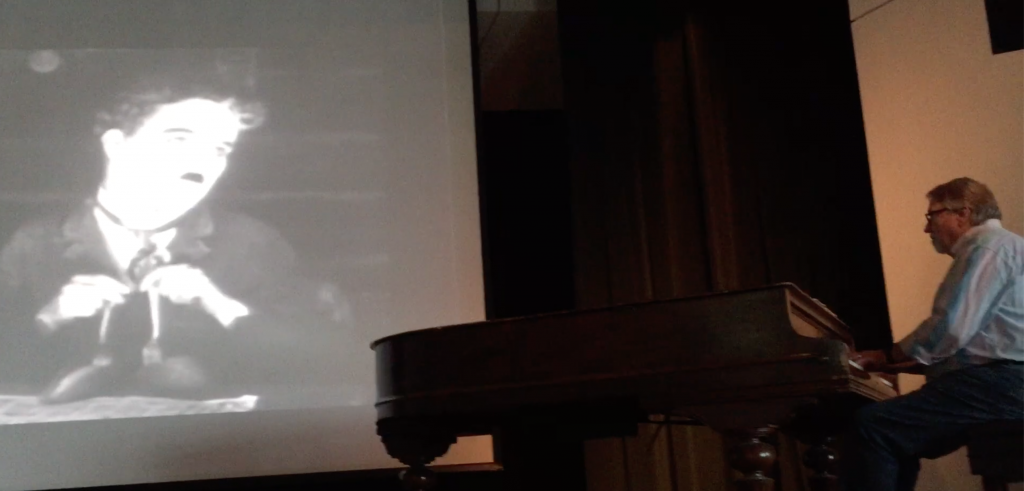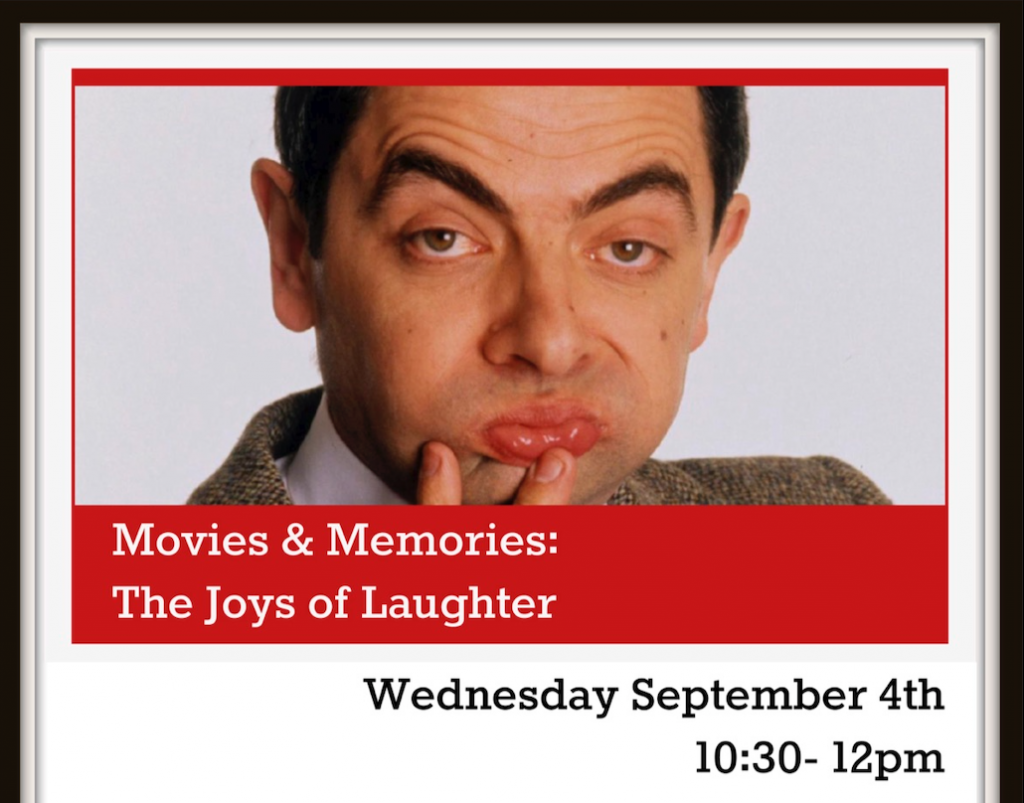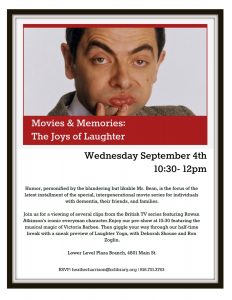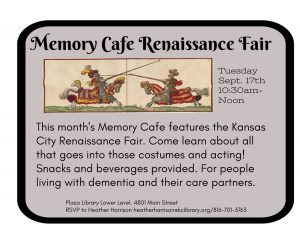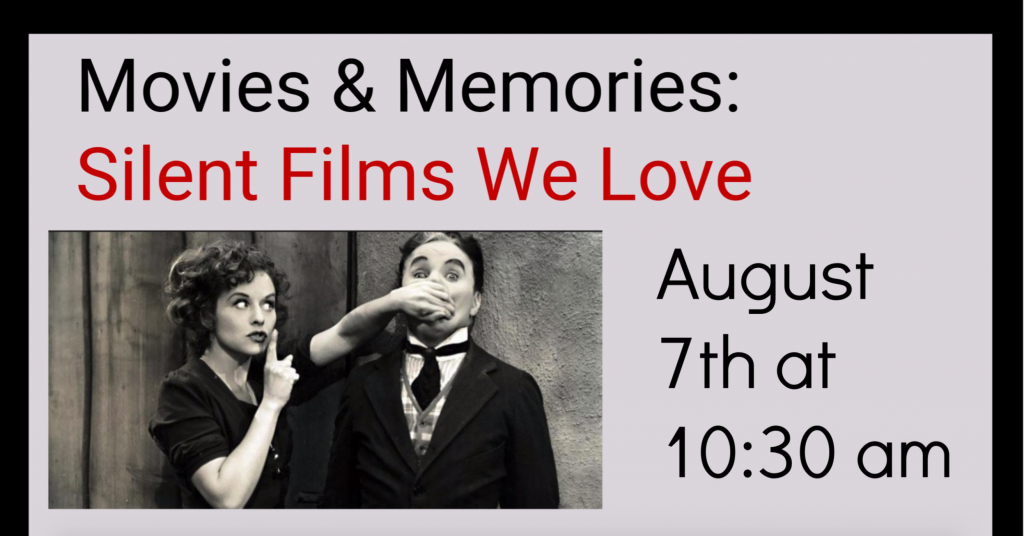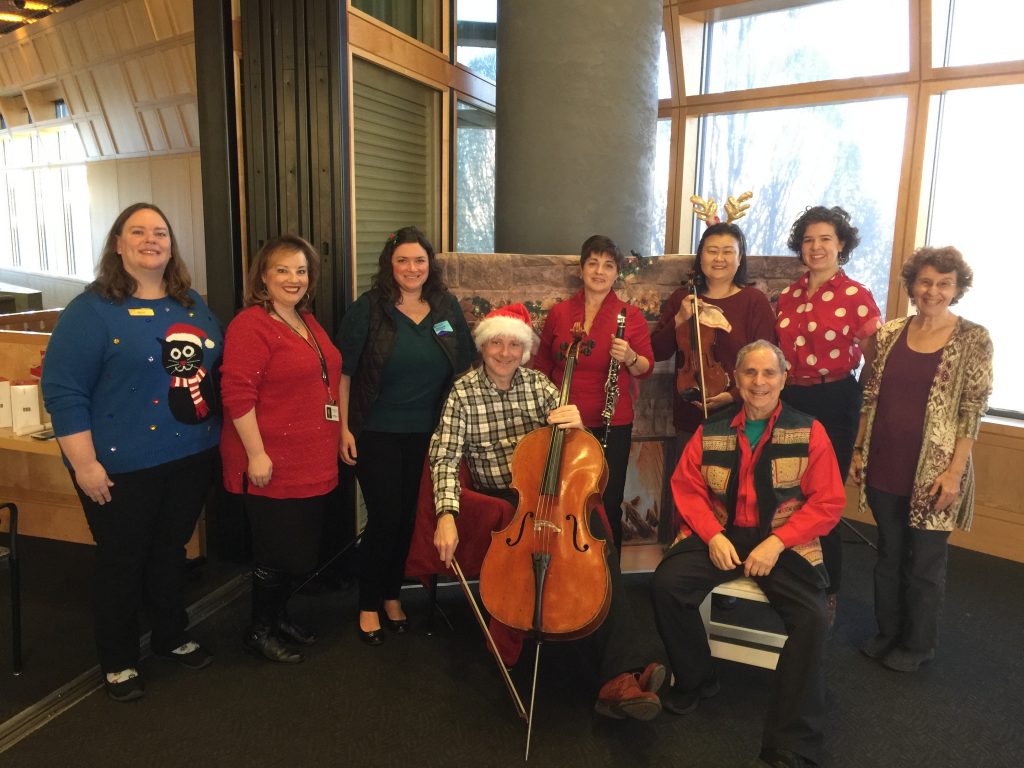Uncategorized
Silent Films Inspire Peals of Laughter at KC Movies & Memories
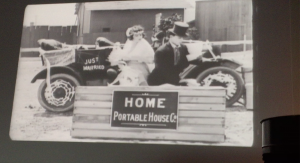 There is something wonderfully connective about watching silent comedies by two of the world’s greats—Charlie Chaplain and Buster Keaton. Those black and white classics make you want to laugh, reminisce, and act a little silly yourself. And when there’s a pianist on hand, punctuating the wit and melodrama, the experience is even more compelling. Those silent films inspired peals of laughter at August’s KC Movies & Memories at the Plaza Library.
There is something wonderfully connective about watching silent comedies by two of the world’s greats—Charlie Chaplain and Buster Keaton. Those black and white classics make you want to laugh, reminisce, and act a little silly yourself. And when there’s a pianist on hand, punctuating the wit and melodrama, the experience is even more compelling. Those silent films inspired peals of laughter at August’s KC Movies & Memories at the Plaza Library.
First, our guest musician, Kenny Harrison, engaged us in a lively sing-a-long. Then 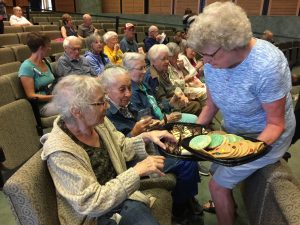 we watched One Week, a Buster Keaton masterpiece. Thomas Cooke is a retired professor of film. He and his wife Deborah spent hours previewing the iconic comedians, picking out three clips just for our program. For anyone who has ever tried to repair or build anything, this short film is a must. Next, Charlie Chaplain entertained us with Oceana Roll. “Charlie’s friends wanted him to do the roll dance every time he dined with them,” Thomas told us. Finally, we were on the edges of our seats with a clip from Modern Times. Note: Roller skate indoors at your own peril.
we watched One Week, a Buster Keaton masterpiece. Thomas Cooke is a retired professor of film. He and his wife Deborah spent hours previewing the iconic comedians, picking out three clips just for our program. For anyone who has ever tried to repair or build anything, this short film is a must. Next, Charlie Chaplain entertained us with Oceana Roll. “Charlie’s friends wanted him to do the roll dance every time he dined with them,” Thomas told us. Finally, we were on the edges of our seats with a clip from Modern Times. Note: Roller skate indoors at your own peril.
Click here to enjoy some moments from this entertaining event.
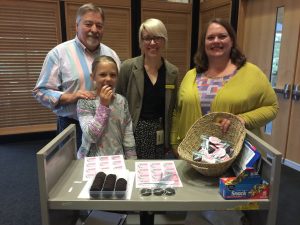 In between films, we talked about the movies and how we related to them. One of our guests was a carpenter. Others had experiences with home repairs. We all marveled when Thomas told us that Keaton did all his own stunts.
In between films, we talked about the movies and how we related to them. One of our guests was a carpenter. Others had experiences with home repairs. We all marveled when Thomas told us that Keaton did all his own stunts.
The movies stayed on our minds for several days. In fact, at dinner two nights later, we tried with Oceana fork dance with cucumbers. (Where are the dinner rolls when you need them?) It was a lot harder than it looked.
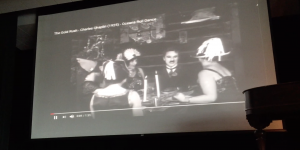
Click to view informative and inspiring short videos on our YouTube channel
Deborah Shouse is the author of Connecting in the Land of Dementia: Creative Activities to Explore Together and Love in the Land of Dementia: Finding Hope in the Caregiver’s Journey.
The Beat Goes on at KC Memory Cafe
 “Drumming ultimately has therapeutic value, providing the emotional and physical benefits collectively known as “drummer’s high,” an endorphin rush that can only be stimulated by playing music, not simply listening to it. …The endorphin-filled act of drumming increases positive emotions and leads people to work together in a more cooperative fashion.” The Neuroscience of Drumming
“Drumming ultimately has therapeutic value, providing the emotional and physical benefits collectively known as “drummer’s high,” an endorphin rush that can only be stimulated by playing music, not simply listening to it. …The endorphin-filled act of drumming increases positive emotions and leads people to work together in a more cooperative fashion.” The Neuroscience of Drumming
Want to experience your own drummer’s high?
Click here and tap along to the beat.
The beat goes on at KC Memory Cafe. Brandon Draper of Drum Safari reminds us how connected we all are by tapping his hand on the table. “No matter where we come from, we all share this internal rhythm, our heartbeat,” he tells us. We tap along with him, and follow his lead as he introduces other more complex beats. Ninety of us are gathered on the lower level of the Plaza Library to experience the magic of drumming, guided by Brandon, his wife, and two daughters. He introduces us to ancient drums and to contemporary instruments. After our briefing in the powerful history of drumming, we all have an opportunity to experience the “drummer’s high.”
The excitement and energy in the room builds as we all make music together. We  are laughing, banging away, singing call and response, and thoroughly engaged in creating cooperative sounds.
are laughing, banging away, singing call and response, and thoroughly engaged in creating cooperative sounds.
People lingered for a long time afterwards, drawn together by the shared experience.
Though Brandon has shared his drumming skills many times, performing at the KC Memory Care touched him deeply. He was thinking of his beloved grandmother, who had lived with dementia. He stayed connected with her through music. “To be here, sharing with all of you, meant so much to me,” he told us.
Our thanks to the wonderful team from Santa Marta Retirement Center, who nourished us with delicious snacks and helped serve everyone. Thanks also to Pam and Beverly, who helped nurture, serve, encourage and keep the beat going on. Want to volunteer or get on our email list? Just contact Heather Harrison, heatherharrison@kclibrary.org 816-701-3763

Click to view informative and inspiring short videos on our YouTube channel
Deborah Shouse is the author of Connecting in the Land of Dementia: Creative Activities to Explore Together and Love in the Land of Dementia: Finding Hope in the Caregiver’s Journey.
Exciting Dementia-Friendly Events
Some Enchanted Beautiful Morning: Movies & Memories Celebrates Inclusion
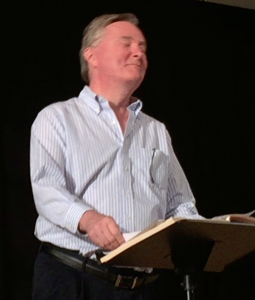 The buzz of conversation ceased as singer/actor Robert Gibby Brand stepped up to the microphone. His accompanist, pianist Robert Pherigo, played the opening bars of Oh, What a Beautiful Morning and Brand soared into the “Bright golden haze on the meadow.” Instantly the audience, ages two to 85 plus, was listening raptly. Brand continued his concert, inviting us to sing along on It’s a Long Way to Tipperary, and melting us with the Cole Porter classic Night and Day. Brand told us the story behind each song and left us wildly applauding after performing Some Enchanted Evening. It was some enchanted beautiful morning at the monthly KC Movies & Memories program.
The buzz of conversation ceased as singer/actor Robert Gibby Brand stepped up to the microphone. His accompanist, pianist Robert Pherigo, played the opening bars of Oh, What a Beautiful Morning and Brand soared into the “Bright golden haze on the meadow.” Instantly the audience, ages two to 85 plus, was listening raptly. Brand continued his concert, inviting us to sing along on It’s a Long Way to Tipperary, and melting us with the Cole Porter classic Night and Day. Brand told us the story behind each song and left us wildly applauding after performing Some Enchanted Evening. It was some enchanted beautiful morning at the monthly KC Movies & Memories program.
But the enchantment didn’t stop there. First we watched the Oscar nominated short, 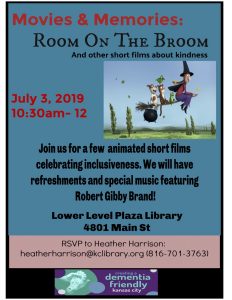 Room on the Broom, which illustrated the joys and challenges of inclusion in a most creative, playful, and poignant way.
Room on the Broom, which illustrated the joys and challenges of inclusion in a most creative, playful, and poignant way.
One of the characters said plaintively, “I am a bird, as green as can be. Is there room on the broom, for a bird like me?” The witch’s clingy cat captured that part in most of us that doesn’t want to share, that believes there is not enough. But the witch reminded us, “Yes, there is room.”
Afterwards we discussed the movie, asking who identified with the clingy cat. All of us had to raise our hands. Then we asked who identified with the witch, who welcomed everyone, and there was a large showing of hands. We also talked about favorite characters and what parts of the film we liked best.
 To finish our mini film-fest, we played an inspiring clip from a Mr. Rogers show, and showed Purl, an 8-minute Pixar film, about how our differences can enrich our lives.
To finish our mini film-fest, we played an inspiring clip from a Mr. Rogers show, and showed Purl, an 8-minute Pixar film, about how our differences can enrich our lives.
It was an inspiring program and everyone left uplifted and delightfully sated by our fresh-made popcorn and other treats.
For a taste of Some Enchanted Beautiful Morning, click here.
A big thanks to our volunteers, Sharon, Julie, and Pam, and to our generous hosts, The Plaza Library.
Want to continue the magic at home?
Room on the Broom is a 20-minute film that is fun for all ages, while being both entertaining and profound. You can easily generate open-ended questions and invite comments and conversation. We talked about, “If you were an animal, which animal would you like to be?” “Who did you identify with?” “What were your favorite parts of the movie?” “Have you ever not wanted to share?”
Want to continue the magic with us? Mark your calendars for the first Wednesday of each month at 10:30. Please join us for our next cafe and our next movie program. For more information, contact Deborah at creativity@pobox.com
Click to view informative and inspiring short videos on our YouTube channel
Deborah Shouse is the author of Connecting in the Land of Dementia: Creative Activities to Explore Together and Love in the Land of Dementia: Finding Hope in the Caregiver’s Journey.
Upcoming KC Dementia Friendly Events
Please join us for these upcoming KC Dementia Friendly events, specially created for people who are living with dementia and their family, friends, and care partners.
All are welcome.
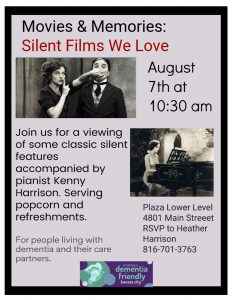

Click to view informative and inspiring short videos on our YouTube channel
Deborah Shouse is the author of Connecting in the Land of Dementia: Creative Activities to Explore Together and Love in the Land of Dementia: Finding Hope in the Caregiver’s Journey.
The Stamp of Fundraising for Dementia: Kudos to Lynda Everman and Kathy Siggins
I am always delighted to get an update from Lynda and Kathy. For years, they promoted the idea of a semi-postal stamp for Alzheimer’s, a stamp that would cost a little more and raise money for the cause. They had to be persistent, dedicated, connective, tireless, creative, and patient. They were.
Their stamp was brought out in November 2017. I was one of the many who were elated. Those are the stamps I buy. I feel joy each time I mail a letter with that semi-postal, knowing that I am raising awareness and money.
I am sending Lynda’s recent updates. I hope you’ll join me in ordering more stamps right now and in encouraging your representatives to support this stamp, as they can extend the life of the stamp. Lynda and Kathy are an example of how two people, enlisting the support of hundreds of others, can make a dramatic difference. Follow your heart into making your own difference.
Warmly,
Deborah
From Lynda:
As of the end of February, 6 million Alzheimer’s stamps have been sold to raise $840,000 for NIH funded dementia research: https://about.usps.com/corporate-social-responsibility/semipostals.htm
 The sales period for the Alzheimer’s semipostal stamp is time-limited…. The Alzheimer’s stamp which was first issued on November 30, 2017 will be removed from sale on November 30, 2019.
The sales period for the Alzheimer’s semipostal stamp is time-limited…. The Alzheimer’s stamp which was first issued on November 30, 2017 will be removed from sale on November 30, 2019.
Let’s see what we can do to EXCEED $1 million raised for NIH funded Alzheimer’s research by November 30th! Please keep purchasing and promoting the stamp which is available at most post offices, online at https://store.usps.com/store/product/buy-stamps/alzheimers-S_564204 and by toll-free phone order at 1-800 STAMP-24.
Here’s another update:
Hello friends,
I am using this tremendous resource from the Alzheimer’s Impact Movement (AIM) to reach out to the health legislative staff of all 535 members of Congress urging all to co-sponsor legislation (H.R. 3113 and S. 1728) requiring the USPS to extend sales of the Alzheimer’s Disease Research Semipostal Stamp for an additional 6 years.
But I need your help! If you’ve not done so already, would you please call or email your Congressperson and Senators and ask for their support? Below are sample scripts/emails for you to use.
FOR CONGRESSPERSONS:
Request to Co-sponsor H.R. 3113
I want to to call attention to proposed bipartisan, bicameral legislation which, if passed, would extend the sales of the US Postal Service Alzheimer’s Disease Research Semipostal Stamp for an additional 6 years.
In less than a year and a half on the market, the Alzheimer’s Stamp has raised over $890,000 for NIH funded research for better treatments, prevention and, one day, a cure for these diseases which have caused too much suffering for far too long. However, despite the fact that 500 million stamps were printed (of which 6.5 million have been sold), without this legislation, all unsold stamps will be removed from sales at the end of November. The passage of this legislation will not increase the Congressional Budget; but it will allow all who use the U.S. mail to continue to voluntarily purchase these stamps to help raise public awareness and funds for critical research.
Please join your colleagues in co-sponsoring H.R. 3113 “To require the United States Postal Service to sell the Alzheimer’s semipostal stamp for 6 additional years.”
Thank you.
FOR SENATORS:
Request to Co-sponsor S. 1728
I want to to call attention to proposed bipartisan, bicameral legislation which, if passed, would extend the sales of the US Postal Service Alzheimer’s Disease Research Semipostal Stamp for an additional 6 years.
In less than a year and a half on the market, the Alzheimer’s Stamp has raised over $890,000 for NIH funded research for better treatments, prevention and, one day, a cure for these diseases which have caused too much suffering for far too long. However, despite the fact that 500 million stamps were printed (of which 6.5 million have been sold), without this legislation, all unsold stamps will be removed from sales at the end of November. The passage of this legislation will not increase the Congressional Budget; but it will allow all who use the U.S. mail to continue to voluntarily purchase these stamps to help raise public awareness and funds for critical research.
Please join your colleagues in co-sponsoring S. 1728 “A bill to require the United States Postal Service to sell the Alzheimer’s semipostal stamp for 6 additional years.”
Click to view informative and inspiring short videos on our YouTube channel
Deborah Shouse is the author of Connecting in the Land of Dementia: Creative Activities to Explore Together and Love in the Land of Dementia: Finding Hope in the Caregiver’s Journey.
Art Invites Conversation
Teri Miller, with the Alzheimer’s Association Houston & Southeast Texas Chapter, has witnessed the power of how art invites conversation. As the Early Stage Program Manager, Teri collaborates with a variety of Houston’s arts and civic organizations.
“Going to cultural activities offers people a sense of normalcy and gives them a date to put on their calendars,” Teri says. “When they go with friends or care partners, they have an experience to discuss. Even people who say, ‘Oh, I don’t care for museums,’ usually have a great time.”
Sam is an example of someone who was surprised to enjoy the art gallery.
He attended one of Teri’s early stage support groups. His wife, who cared for him at home, went to the care partner’s group. Teri formed a partnership with the Houston Museum of Fine Arts and invited her early stage group to experience a tour. When he heard the invitation, Sam rolled his eyes and said, “I’ve never been to a museum and I’m not about to start now.”
But the next week, Sam signed up for the tour.
“What made you change your mind?” Teri asked.
“My wife really wanted to go. She does so much for me, I figured I’d do something for her.”
Teri expected Sam to sit back silently, arms folded over his chest, as the docent asked, “What does this painting make you think of? Has anyone ever been in a similar setting?” But to Teri’s surprise, Sam had opinions on each of the three pieces they discussed.
Sam told Teri, “At first, I didn’t want to go because I was worried I wouldn’t have anything meaningful to contribute. But I guess you don’t have to know anything about art to enjoy the museum.”
He and his wife talked about the experience all the way home. Discussing the paintings opened up chances to reminisce and connect. Plus the experience gave them something interesting to share with their grown children and visiting neighbors.
Like many art partnerships around the country, Teri was inspired by MOMA’s Meet Me art program for people living with dementia. The Houston museum benefitted from MOMA coming to train their docents. The program offers comprehensive guidelines for visiting a museum or viewing art at home.
Creative Sparks:
Many art galleries and museums offer special tours and events for people living with dementia. If you’re lucky enough to have such a tour available, take advantage of it.
To design your own museum tour:
- Think of a museum your partner likes. If feasible, buy postcards of some of their art or visit their on-line gallery together and ask your partner which pieces he prefers. That way, you can tailor the visit to his taste.
- Choose one or two rooms that feature his preferred art. Make sure one room has a place to sit.
- Use the paintings and sculptures as a catalyst for conversation. Ask open-ended questions, discussing the colors, people, and objects you both notice.
- If the museum has a restaurant or tearoom, treat yourselves to something delicious.
- Enjoy the sense of connection that comes from discussing art; there are no right or wrong answers, just interesting observations.
- To fashion a viewing experience at home:
- Select art books from the library or use your own personal collection.
- Choose works that portray emotion, tell a story or align with your partner’s background or interests.
- Ask open-ended questions that invite conversation, such as, “What does this make you think of?” and “What do you notice in this picture?” Have fun imagining what the people in the painting are thinking. Imagine their professions and whether they’re happy.
This is an excerpt from Connecting in the Land of Dementia: Creative Activities to Explore Together. Deborah also wrote Love in the Land of Dementia: Finding Hope in the Caregiver’s Journey.
Santa and the Symphony Visit the KC Memory Cafe
 At our December Memory Cafe, Santa had an amazing pre-show- warm-up band: a trio from the Kansas City Symphony. Their renditions of familiar holiday tunes were musical works of art, filled with melodic flourishes and surprises. Our guests listened avidly. When Stephanie Brimhall, the Symphony’s Education Manager, led us in a singalong, everyone raised their voices and sang with heart and gusto. As our attendees finished decorating Christmas cookies with colorful icings, bright sprinkles, and little chunks of peppermint, we heard a jingling of bells and a booming, “Ho Ho Ho.” Santa had arrived, with a sack of treats.
At our December Memory Cafe, Santa had an amazing pre-show- warm-up band: a trio from the Kansas City Symphony. Their renditions of familiar holiday tunes were musical works of art, filled with melodic flourishes and surprises. Our guests listened avidly. When Stephanie Brimhall, the Symphony’s Education Manager, led us in a singalong, everyone raised their voices and sang with heart and gusto. As our attendees finished decorating Christmas cookies with colorful icings, bright sprinkles, and little chunks of peppermint, we heard a jingling of bells and a booming, “Ho Ho Ho.” Santa had arrived, with a sack of treats.
“How many of you have been good?” Santa asked and most of us raised our hands. Santa made the rounds, passing out sweet treats, courtesy of Russell Stover Chocolates, and wishing everyone a merry holiday.  Then he settled into a comfortable chair beside the backdrop of a scenic hearth. We all lined up to sit beside him and have our photos taken with the Great Claus. Santa warmly welcomed each person and everyone was just thrilled to be near him — and even more thrilled when Jennifer Walker’s remarkable little printer produced a wonderful photographic memento of the event.
Then he settled into a comfortable chair beside the backdrop of a scenic hearth. We all lined up to sit beside him and have our photos taken with the Great Claus. Santa warmly welcomed each person and everyone was just thrilled to be near him — and even more thrilled when Jennifer Walker’s remarkable little printer produced a wonderful photographic memento of the event.
At the end, Santa summed up the holiday spirit by sharing this message: “Peace for the world and good will for all people.”
We hope we can all continue this spirit of hope, sharing, and generosity throughout the new year.
Capture the cafe spirit for yourself by clicking on this short video:
Deborah Shouse is the author of Connecting in the Land of Dementia: Creative Activities to Explore Together and Love in the Land of Dementia: Finding Hope in the Caregiver’s Journey.
An Old-Fashioned Holiday
This old-fashioned holiday story from Love in the Land of Dementia: Finding Hope in the Caregiver’s Journey celebrates the spiritual aspects of living with dementia.
When I walk through the doors of the nursing home, I find my mother in her wheelchair, right in front of the medication cart, right behind the central nursing station, where nurses, delivery people, staff and family members congregate. Mom is bent over, her baby doll lying across her lap. When I walk up to her, I ratchet up my energy and widen my smile. I am preparing to clown her into a reaction.
Later my father will ask if I think she recognized me.
“No,” I will have to tell him. “She did not recognize me. But she did smile.”
The smile is important.
My hand waving and head bobbing does its work: Mom does smile, and I can tell she is in her own current version of a good mood.
“Music in the dining room,” the activity board reads, so I wheel her in that direction. An elderly man with a red and white trimmed Santa hat passes us in the hallway.
“Look Mom, there’s Santa,” I tell her.
Having been brought up Jewish, Mom never was all that enthralled with the Claus mythology and she has not changed.
A white-haired woman is in the dining room, busily setting up for the music program. Several patients are already gathered. The woman takes out a microphone, a boom box, an illuminated plastic snowman, and a small silver bell. I continue wheeling Mom down the far corridor, liking the sense of companionship I have from this movement.
As we stroll, a nurse carrying a plate of lettuce walks past us.
“She must have been a good mother,” she says, nodding at the way Mom is holding the baby. “She must still be a good mother.”
“She is,” I say.
I have never really said to my mom, “You were a good mother.”
Now I realize she was.
I can see that Mom is enjoying the ride. She loved movement when she was younger and was far more adventuresome than Dad when it came to airplanes, ski lifts, fast cars, and speedy boats. For her, biting breeze across the face was thrilling, not threatening. Until she became a mother, that is. Then she abandoned her pleasure in the heights and speed and concentrated on making sure we were slow, safe, and centered.
We roll back into the dining room just as the show is ready to start. The singer, Thelda, kicks off her shoes and presses play on the boom box. Above the cheerful sound track, she sings Jingle Bells. She dances across the room with the remnants of ballroom steps. She stops in front of Mom and sings right to her. She gets on her knees, so she can look into Mom’s eyes, and keeps singing. Mom notices her and smiles a little.
Thelda moves on, singing to each of the patients gathered around, so intent on making a connection that she often forgets the words.
“Is it all right for your Mom to come to Christmas holiday events?” the activity director had asked me, when Mom moved from the memory care into the skilled care portion of the nursing home.
“Yes, I’d like her to go to any activities. She likes the extra energy.”
I think Mom would approve of my decision, even though she has never celebrated Christmas. Growing up, her immigrant mother held on to the Jewish spirit of her home, kneading dough for Friday evening challah, observing each holiday and prayer period in her own way. Some orthodox women followed the religious law that commanded a small piece of the dough be burned as an offering to God. My grandmother was poor; she did not believe in burning good food, regardless of tradition. So she sacrificed a portion of the dough to her youngest daughter, my mother Fran. She created a “bread tail,” leftover dough that she smeared with butter and sprinkled with sugar and baked. When Mom used to talk about her mother, she always mentioned this special treat.
Even when I was growing up, and we were the only Jewish family in our neighborhood, my mother still did not sing Christmas songs. She did not willingly go to Christmas parties. She let the holiday rush by her, like a large train, whooshing past, ruffling her hair and leaving her behind.
Now, I am singing Christmas carols to my Mom for the first time. She is smiling, though really not at me. But I am sitting beside her while she is smiling and that makes me happy. She has moved beyond the place where the religions are different, beyond the place where she wants to separate the dough and make a sacrifice for tradition. Her new tradition is anyone who can make her smile.
With each song, from White Christmas, to Silver Bells, to Frosty the Snowman, Thelda moves back to Mom, tapping her, nudging her, shaking a bell almost in her face, acting sillier and sillier. Each time, Mom lifts her head and widens her mouth for a second.
For her finale, Thelda puts on a big red nose and sings Rudolph. When she dances in front of Mom with that nose, Mom laughs. For several minutes, Mom stays fixated on the scarlet nose, her face a miracle in pure enjoyment. I laugh too, so delighted to see Mom engaged and absorbed. Then, Thelda dances away and Mom’s face glazes back over.
Two weeks from now, I will bring a menorah and candles into my mother’s room. My father and I will have a short Chanukah ceremony with Mom. She will pick at the shiny paper covering the Chanukah gelt (chocolate candy disguised as money). She will slump over in her chair. But she will come back to life when she sees me, her only daughter, wearing a big red nose as I light the menorah.
Deborah Shouse is the author of Connecting in the Land of Dementia: Creative Activities to Explore Together and Love in the Land of Dementia: Finding Hope in the Caregiver’s Journey.
Eight Steps to Help People Living with Dementia Feel at Ease during Holiday Gatherings
As we move into the holiday season, Ron and I think often of our parents who went through their last holidays with dementia: my mom Frances and his father Frank. We wanted to share the season with them in ways that felt safe, comfortable, and honoring so we gradually developed these tips. Recently, we shared the tips via email and had such a great response we also want to share them with you.
Several people wrote, “These ideas are good for anyone, not just those with memory loss.”
What great wisdom–to treat each person with the tenderness and consideration that we often reserve for someone going through a physical or emotional illness.
We’d like to share our tips and we’d like to learn from you: what other suggestions do you have for helping people feel connected at gatherings?
Eight Steps to Help People Living with Dementia Feel at Ease during Holiday Gatherings
- When you’re in a group, help the person living with dementia feel safe and comfortable by having a trusted friend or family member stay beside him or her, explaining the proceedings and fielding questions from others, as needed.
- Encourage people to say their name and maintain eye contact when conversing with the person who is living with dementia.
- Make sure the person can come and go from the group as needed. Create a quiet space where he or she can rest — or appoint a caring person to drive your loved one home when he tires of the festivities.
- Have something special for them to look at, like a family photo album or a favorite magazine.
- Choose background music that is familiar to them, music of their era played in a style they resonate with.
- Prepare a few of their favorite foods.
- When talking to them, don’t correct or contradict or try to pull them into the current reality. Simply listen carefully and let them talk.
- Appreciate them for who they are right now.
Here’s to a holiday season filled with grace, gratitude and generosity.

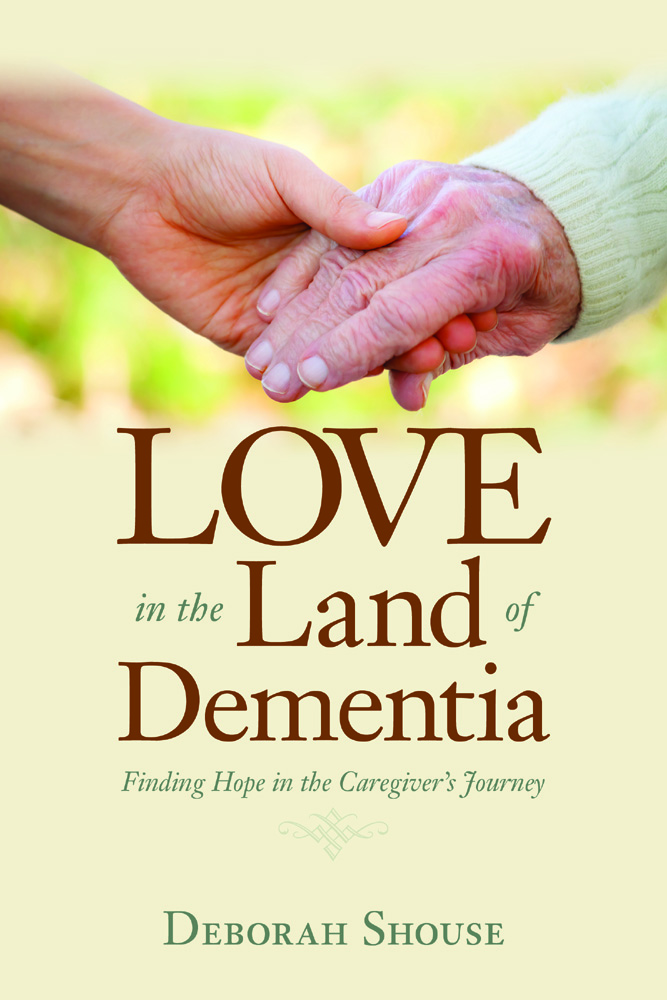
Deborah Shouse is the author of Love in the Land of Dementia: Finding Hope in the Caregiver’s Journey.
